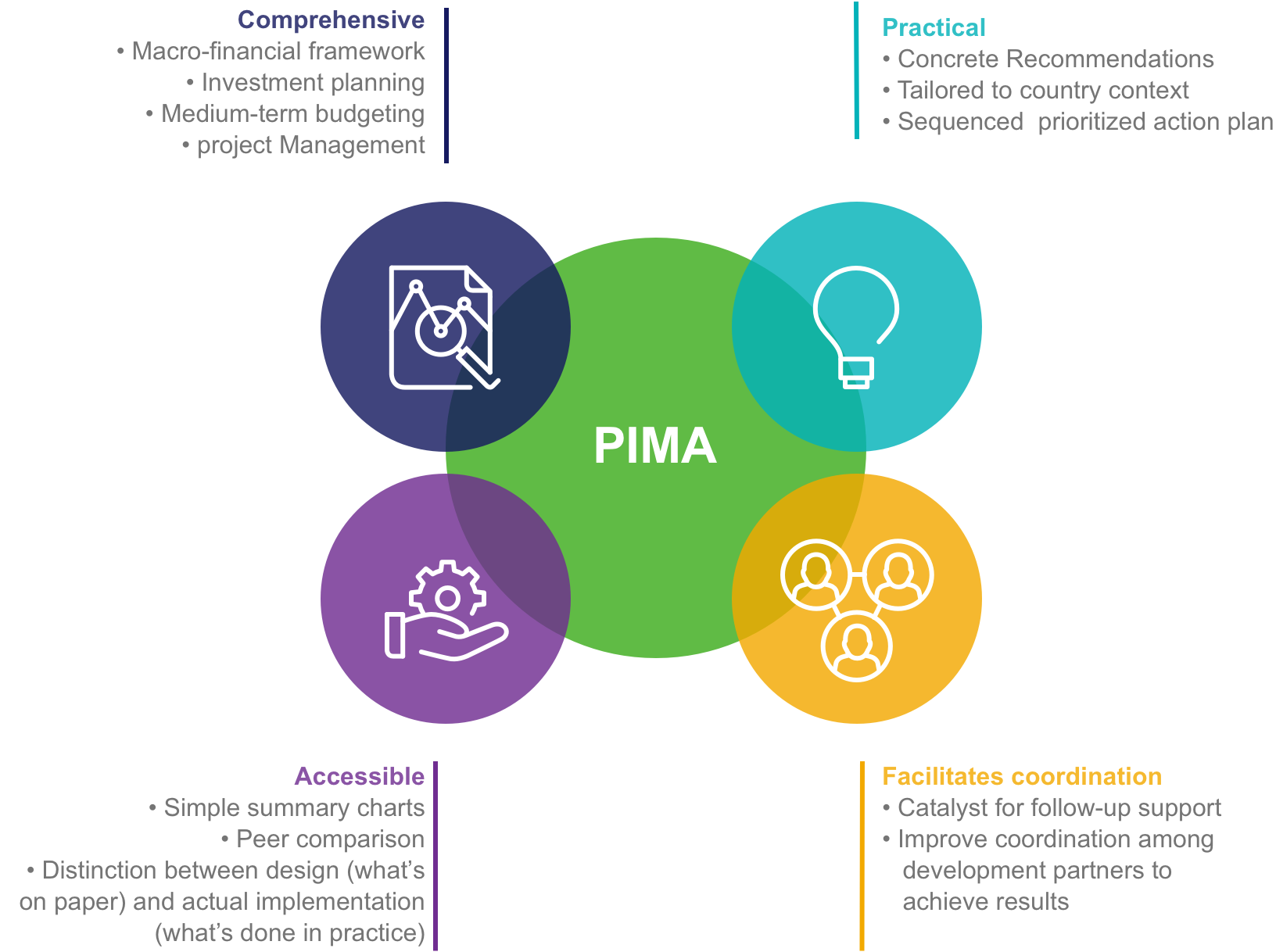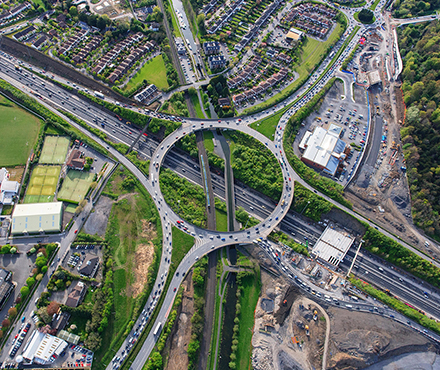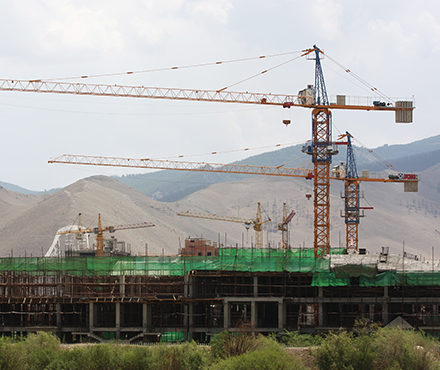Public Investment Management Assessment (PIMA) is a comprehensive framework to assess infrastructure governance practices for countries at all levels of economic development. Specifically, PIMA evaluates 15 institutions involved in the three key stages of the public investment cycle:
- Planning of sustainable investment across the public sector;
- Allocation of investment to the right sectors and projects;
- Implementation of investments projects to deliver productive and durable public assets.
Each institution is assessed on both institutional strength (the organization, policies, rules and procedures on paper) and effectiveness (the degree to which the intended purpose is being achieved in practice or there is a clear useful impact).
PIMA also covers a qualitative assessment of three cross-cutting factors that often impact the overall effectiveness of public investment management: (1) the legal and regulatory framework, (2) staff capacity, and (3) IT systems.
(Click on the interactive chart to explore)
Loading...
1.
Fiscal Targets and Rules:
1.a. Is there a target or limit for government to ensure debt sustainability?
1.b. Is fiscal policy guided by one or more permanent fiscal rules?
1.c. Is there a medium-term fiscal framework (MTFF) to align budget preparation with fiscal policy?
2.
National and Sectoral Planning:
2.a. Does the government prepare national and sectoral strategies for public investment?
2.b. Are the government’s national and sectoral strategies or plans for public investment costed?
2.c. Do sector strategies include measurable targets for the outputs and outcomes of investment projects?
3.
Coordinating Between Entities:
3.a. Is capital spending by SNGs, coordinated with the central government?
3.b. Does the central government have a transparent, rule-based system for making capital transfers to SNGs, and for providing timely information on such transfers?
3.c. Are contingent liabilities arising from capital projects of SNGs, PCs, and PPPs reported to the central government?
4.
Project Appraisal:
4.a. Are major capital projects subject to rigorous technical, economic, and financial analysis?
4.b. Is there a standard methodology and central support for the appraisal of projects?
4.c. Are risks taken into account in conducting project appraisals?
5.
Alternative Infrastructure Financing:
5.a. Does the regulatory framework support competition in contestable markets for economic infrastructure (e.g., power, water, telecoms, and transport)?
5.b. Has the government published a strategy/policy for PPPs, and a legal/regulatory framework which guides the preparation, selection, and management of PPP projects?
5.c. Does the government oversee the investment plans of public corporations (PCs) and monitor their financial performance?
6.
Multiyear Budgeting:
6.a. Is capital spending by ministry or sector forecasted over a multiyear horizon?
6.b. Are there multiyear ceilings on capital expenditure by ministry, sector, or program?
6.c. Are projections of the total construction cost of major capital projects published?
7.
Budget Comprehensiveness and Unity:
7.a. Is capital spending mostly undertaken through the budget?
7.b. Are all capital projects, regardless of financing source, shown in the budget documentation?
7.c. Are capital and recurrent budgets prepared and presented together in the budget?
8.
Budgeting for Investment:
8.a. Are total project outlays appropriated by the legislature at the time of a project’s commencement?
8.b. Are in-year transfers of appropriations (virement) from capital to current spending prevented?
8.c. Is the completion of ongoing projects given priority over starting new projects?
9.
Maintenance and Funding:
9.a. Is there a standard methodology for estimating routine maintenance needs and budget funding?
9.b. Is there a standard methodology for determining major improvements (e.g. renovations, reconstructions, enlargements) to existing assets, and are they included in national and sectoral investment plans?
9.c. Can expenditures relating to routine maintenance and major improvements be identified in the budget?
10.
Project Selection:
10.a. Does the government undertake a central review of major project appraisals before decisions are taken to include projects in the budget?
10.b. Does the government publish and adhere to standard criteria, and stipulate a required process for project selection?
10.c. Does the government maintain a pipeline of appraised investment projects for inclusion in the annual budget?
11.
Procurement:
11.a. Is the procurement process for major capital projects open and transparent?
11.b. Is there a system in place to ensure that procurement is monitored adequately?
11.c. Are procurement complaints review process conducted in a fair and timely manner?
12.
Availability of Funding:
12.a. Are ministries/agencies able to plan and commit expenditure on capital projects in advance on the basis of reliable cash-flow forecasts?
12.b. Is cash for project outlays released in a timely manner?
12.c. Is external (donor) funding of capital projects fully integrated into the main government bank account structure?
13.
Portfolio Management and Oversight:
13.a. Are major capital projects subject to monitoring during project implementation?
13.b. Can funds be re-allocated between investment projects during implementation?
13.c. Does the government adjust project implementation policies and procedures by systematically conducting ex post reviews of projects that have completed their construction phase?
14.
Management Project Implementation:
14.a. Do ministries/agencies have effective project management arrangements in place?
14.b. Has the government issued rules, procedures and guidelines for project adjustments that are applied systematically across all major projects?
14.c. Are ex post audits of capital projects routinely undertaken?
15.
Monitoring of Public Assets:
15.a. Are asset registers updated by surveys of the stocks, values, and conditions of public assets regularly?
15.b. Are nonfinancial asset values recorded in the government financial accounts?
15.c. Is the depreciation of fixed assets captured in the government’s operating statements?
 |
Cross-Cutting Institutions Legal Framework, IT System, Staff Capacity |
 |
(Click through the slide show to learn how PIMA data is measured and evaluated)
Comprehensive assessment |
PIMA reports include a set of prioritized recommendations and action plans tailored to each country. Because these are produced through a consultative approach encompassing government ministries and agencies, development partners, and other actors, these recommendations typically have broad support. Many countries have taken actions to implement PIMA recommendations.
Examples of government actions to implement PIMA recommendations:
The PIMAs conducted so far provide valuable insights into the strength of infrastructure governance institutions across countries.
- All countries, most notably emerging markets and low-income developing countries, have significant room to improve their infrastructure governance to increase effectiveness in public investment.
- Countries generally score higher on institutional design than effectiveness. This points to the critical importance of having institutions that are not only well-designed, but also function well in practice.
- The gap between institutional design and effectiveness is most pronounced for low-income developing countries, reflecting weak implementation capacity in these countries.
- Across the three key stages of the public investment cycle—planning, allocation, and implementation—the lowest effectiveness scores and highest gaps are generally recorded in the allocation and implementation stages, when assets are selected, monitored, and maintained.
- Countries often score more poorly in institutions specific to public investment decision making (e.g. project appraisal, project selection, and maintenance funding), compared to more general public financial management institutions (e.g. budget comprehensiveness and availability of funding).











